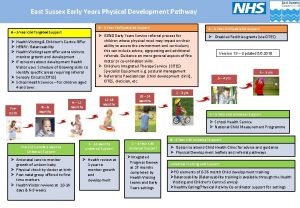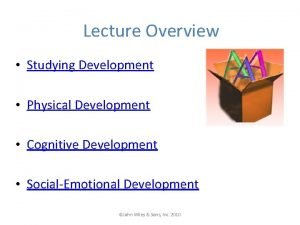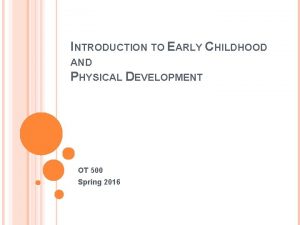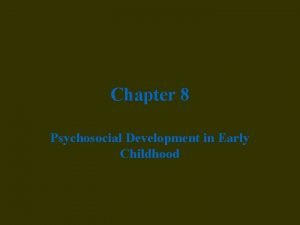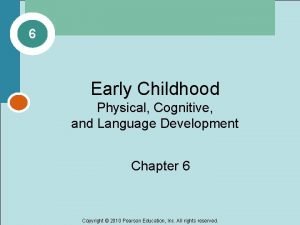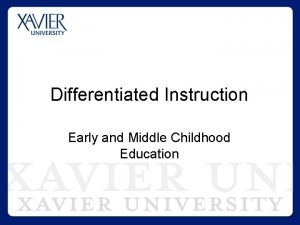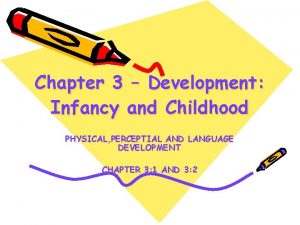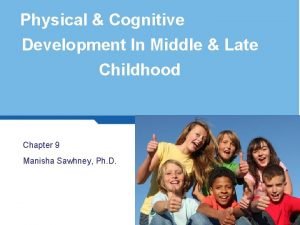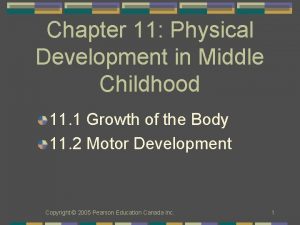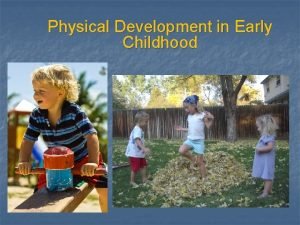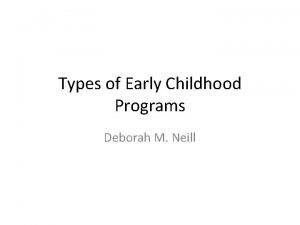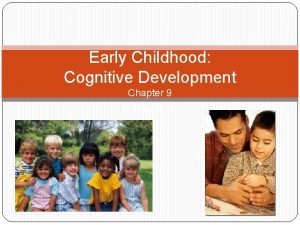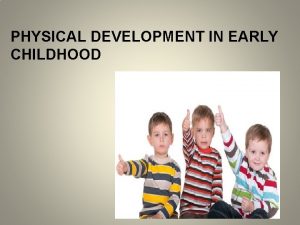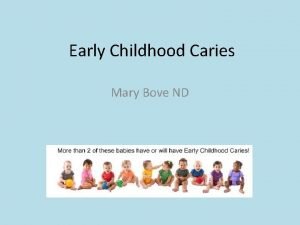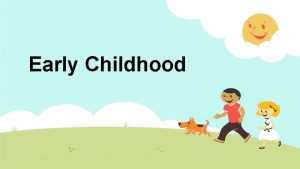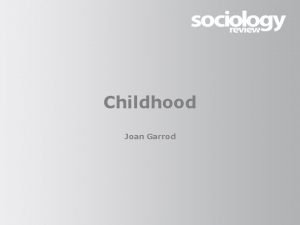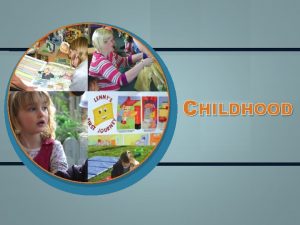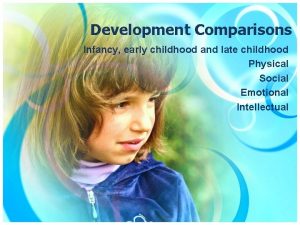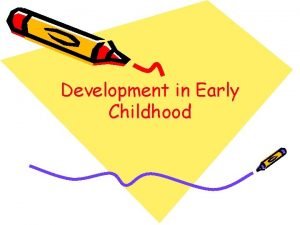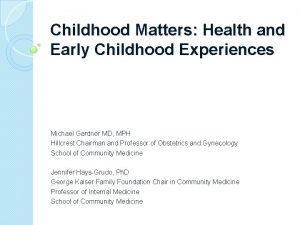Physical Development in Early Childhood Physical Development in























- Slides: 23

Physical Development in Early Childhood

Physical Development in Early Childhood Body growth slows n Shape becomes more streamlined. n 2 -3” in height/yr n 5 pounds/year Skeletal growth continues. n New growth centers emerge. n Lose baby teeth

Brain Development in Early Childhood Significant brain growth between ages 2 and 6: n n n Grows to 90% of adult size Reshaping and refining Overabundance of synaptic connections supports plasticity Cognitive skills also increase. n Physical coordination, perception, attention, memory, language, logical thinking, and imagination Copyright © 2012 Pearson Education, Inc. All Rights Reserved.


Age-Related Changes in Synaptic Density of Three Areas of Cerebral Cortex Involved in Language Processing Figure 8. 2

Brain Development in Early Childhood (continued) Frontal lobe areas for planning and organization develop. Left hemisphere active n Language skills n Handedness Differences in rate of development between the two hemispheres suggest they continue to lateralize during early childhood.

Handedness Begins as early as 1 year and strengthens 90% are right-handed (in Western nations) Affected by experience n n n Position in uterus Practice Culture Early damage to left hemisphere may cause shift in handedness. n © Jarenwicklund | Dreamstime. com However, most left-handers have no developmental problems and are more likely to excel in both verbal and math skills. Copyright © 2012 Pearson Education, Inc. All Rights Reserved.

Cross-Section of the Human Brain Copyright © 2012 Pearson Education, Inc. All Rights Reserved.

Influences on Physical Growth and Health Heredity and hormones Emotional well-being n Psychosocial dwarfism Sleep Nutrition Infectious disease n Immunization Childhood injuries © Ron Chapple Studios | Dreamstime. com

Heredity and Hormones Size and growth related to parents Genes influence pituitary gland to release: n Growth hormone (GH) acts directly, but also stimulates release of insulinlike growth factor 1 (IGF-1), which triggers cell duplication. n Thyroid-stimulating hormone (TSH) prompts release of thyroxine; necessary for brain development and proper growth.

Nutrition in Early Childhood Appetite becomes unpredictable. Like familiar foods Social environment influences food choices. Children who have a nutritionally deficient diet have § more attention difficulties. § poorer mental test scores. § behavior problems, especially hyperactivity and aggression. Copyright © 2012 Pearson Education, Inc. All Rights Reserved. © Haitao Wang | Dreamstime. com

Infectious Diseases in Childhood About 20% of American infants and toddlers are not fully immunized. n Rate is higher for poverty-stricken children. § One in five children under age 5 in the U. S. have no health insurance and limited access to care. § In other industrialized nations, free medical examinations are standard. § Children’s Health Insurance Program (CHIP) funding provides care for many, but some eligible children are not enrolled.

Factors Related to Childhood Injuries Individual Differences § Gender— § Mothers judge chances of preventing injury in sons to be lower—a belief that might keep them from exercising proper controls. Temperament § Risk Factors § § § Poverty, single parenthood, low parental education Societal conditions in developing nations Poverty, child-care shortages, teen parents in the U. S. Copyright © 2012 Pearson Education, Inc. All Rights Reserved.

Leading causes of death among children aged 1 -4, 2007 Age Group 1 -4 Years Type of Injury Death Rate per 100, 000 Population in Specified Age Group Unintentional Injury 9. 6 Congenital Anomalies 3. 3 Homicide 2. 4 Malignant Neoplasms (cancer) 2. 2 Heart Disease 1. 1 Influenza and Pneumonia 0. 7 Septicemia 0. 5 Conditions Originating in 0. 4 the Perinatal Period

Preventing Childhood Injuries Laws prevent many injuries (safety seats, childresistant caps, flameproof clothing). Many parents and children still behave in ways that compromise safety. n Safety seats— 40% of parents don’t place their children in child safety seats, and of those that do, 84% either install them or use them incorrectly. n Parents expect small children to recall safety rules, rather than monitoring and controlling access to hazards. Copyright © 2012 Pearson Education, Inc. All Rights Reserved.

Motor Skill Development in Early Childhood Gross-motor skills n Walking, running n Catching, throwing, swinging, riding Fine-motor skills n Self-help: © Silisia | Dreamstime. com eating n Drawing Copyright © 2012 Pearson Education, Inc. All Rights Reserved. dressing,

Changes in Catching During Early Childhood Figure 8. 8 Copyright © 2012 Pearson Education, Inc. All Rights Reserved.

Progression of Drawing Skills Scribbles: during 2 nd year First representational forms Label already-made drawings around age 3 n Draw boundaries and people at 3– 4 years n More realistic drawings: preschool to school age Early printing: ages 4– 6 Figure 8. 9

Development of Children’s Drawings of Geometric Objects Figure 8. 10 Copyright © 2012 Pearson Education, Inc. All Rights Reserved.

Kellogg’s stages of young children’s artistic drawings 2 yrs: scribbles 2 -3 yrs: placement stage 3 yrs: shape stage 3 -4 yrs: design stage 4 -5 yrs: pictorial stage

Development of Printing in Early Childhood Up to Age 3 Around Age 4 Between Ages 4 and 6 n Scribbles n Varied pencil grips n “Drawing print” n Gradually realize writing stands for language, identify individual letters n Adult pencil grip by age 5 Copyright © 2012 Pearson Education, Inc. All Rights Reserved.

Individual Differences in Motor Skills Body build n Taller and more muscular bodies move more quickly, acquire skills faster. Sex n n n Boys: Girls: Social pressures help channel activities.

Enhancing Early Childhood Motor Development Mastered through everyday play n Formal lessons have little impact. n Preschoolers should have at least 60 minutes of unstructured play every day. Daily routines support fine-motor development. Provide appropriate play space and equipment. Outdoor Education Activists: nature play!; exercise but also engages parasympathetic NS in addition to sympathetic
 Middle childhood is from
Middle childhood is from Physical development in early childhood
Physical development in early childhood Physical development in early childhood
Physical development in early childhood Fine motor skills development in early childhood
Fine motor skills development in early childhood Psychosocial development in early childhood
Psychosocial development in early childhood Language development in early childhood
Language development in early childhood A vygotskian classroom promotes ________.
A vygotskian classroom promotes ________. Biosocial child development
Biosocial child development Early childhood development with differentiated instruction
Early childhood development with differentiated instruction Physical development in middle childhood
Physical development in middle childhood Infancy and childhood physical development
Infancy and childhood physical development Late childhood physical development
Late childhood physical development Physical development in middle childhood chapter 11
Physical development in middle childhood chapter 11 Physical development in middle childhood
Physical development in middle childhood Cognitive development in middle and late childhood
Cognitive development in middle and late childhood Rovee-collier
Rovee-collier Types of early childhood programs
Types of early childhood programs Types of early childhood programs chapter 2
Types of early childhood programs chapter 2 E f q
E f q Early childhood framework for quality
Early childhood framework for quality Rockefeller college professional development program
Rockefeller college professional development program Welcome dear parents
Welcome dear parents Early childhood education and care directorate
Early childhood education and care directorate Leonard di vinci
Leonard di vinci

